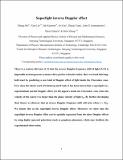| dc.contributor.author | Shi, Xihang | |
| dc.contributor.author | Lin, Xiao | |
| dc.contributor.author | Kaminer, Ido | |
| dc.contributor.author | Gao, Fei | |
| dc.contributor.author | Yang, Zhaoju | |
| dc.contributor.author | Joannopoulos, John D. | |
| dc.contributor.author | Soljacic, Marin | |
| dc.contributor.author | Zhang, Baile | |
| dc.date.accessioned | 2020-04-30T19:36:34Z | |
| dc.date.available | 2020-04-30T19:36:34Z | |
| dc.date.issued | 2018-07 | |
| dc.date.submitted | 2017-11 | |
| dc.identifier.issn | 1745-2473 | |
| dc.identifier.issn | 1745-2481 | |
| dc.identifier.uri | https://hdl.handle.net/1721.1/124952 | |
| dc.description.abstract | It has long been thought that the inverse Doppler frequency shift of light is impossible in homogeneous systems with a positive refractive index. Here we break this long-held tenet by predicting a previously unconsidered Doppler effect of light inside a radiation cone, the so-called Vavilov–Cherenkov cone, under specific circumstances. It has been known from the classic work of Ginzburg and Frank that a superlight (that is, superluminal) normal Doppler effect appears inside the Vavilov–Cherenkov cone if the velocity of the source v is larger than the phase velocity of light v[subscript p]. By further developing their theory, we discover that an inverse Doppler frequency shift will arise if v > 2v[subscript p]. We denote this as the superlight inverse Doppler effect. Moreover, we show that the superlight inverse Doppler effect can be spatially separated from the other Doppler effects by using highly squeezed polaritons (such as graphene plasmons), which may facilitate the experimental observation. | en_US |
| dc.description.sponsorship | Singapore. Ministry of Education (Grant MOE2015-T2-1-070) | en_US |
| dc.description.sponsorship | Singapore. Ministry of Education (Grant MOE2016-T3-1-006) | en_US |
| dc.description.sponsorship | Singapore. Ministry of Education (Grant Tier 1 RG174/16 (S) | en_US |
| dc.description.sponsorship | Massachusetts Institute of Technology. Institute for Soldier Nanotechnologies (Contract W911NF-18-2-0048) | en_US |
| dc.description.sponsorship | Massachusetts Institute of Technology. Institute for Soldier Nanotechnologies (Contract W911NF-13-D-0001) | en_US |
| dc.publisher | Springer Nature America, Inc | en_US |
| dc.relation.isversionof | http://dx.doi.org/10.1038/S41567-018-0209-6 | en_US |
| dc.rights | Article is made available in accordance with the publisher's policy and may be subject to US copyright law. Please refer to the publisher's site for terms of use. | en_US |
| dc.source | arXiv | en_US |
| dc.title | Superlight inverse Doppler effect | en_US |
| dc.type | Article | en_US |
| dc.identifier.citation | Shi, Xihang et al. “Superlight Inverse Doppler Effect.” Nature Physics 14, 10 (July 9, 2018): 1001–1005. © 2018 the Authors | en_US |
| dc.contributor.department | Massachusetts Institute of Technology. Department of Physics | en_US |
| dc.relation.journal | Nature Physics | en_US |
| dc.eprint.version | Original manuscript | en_US |
| dc.type.uri | http://purl.org/eprint/type/JournalArticle | en_US |
| eprint.status | http://purl.org/eprint/status/NonPeerReviewed | en_US |
| dc.date.updated | 2019-03-28T17:22:43Z | |
| dspace.embargo.terms | N | en_US |
| dspace.date.submission | 2019-04-04T12:17:21Z | |
| mit.journal.volume | 14 | en_US |
| mit.journal.issue | 10 | en_US |
| mit.license | PUBLISHER_POLICY | en_US |
| mit.metadata.status | Complete | |
